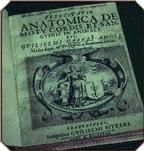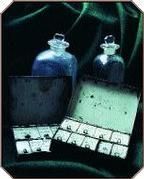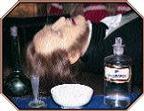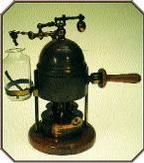Article
Here's to the giants of medicine
Author(s):
The profession's past is rich in heroes. Among the most notable are the scientists profiled here.
Here's to the giants of medicine
The profession's past is rich in heroes. Among the mostnotable are the scientists profiled here.
Text and photos by Eric G. Anderson, MD
Family Physician / San Diego
The turn of the millennium is a time to look both forward and back. Forwardcan be fun, but as doctors we have plenty to look back uponand appreciate.
A mere 500 years ago, mankind wasn't at all clear on how the body worked,wasn't even certain of all the parts. Today we engineer genes. Many brilliantscientists brought us to this point, andbecause medical history is oneof my hobbiesI have visited a number of their shrines. With considerablehumility, I've held Lister's carbolic spray device, Pasteur's lab bottles,and Osler's copy of Vesalius' Fabrica. I've stood in Fleming's labat St. Mary's Hospital and looked through Sabin's microscope in Cincinnati.
This is a tribute to a handful of the medical giants.

Andreas Vesalius
For more than 1,300 years after his death in AD 200, the Greek physicianGalen stood as the world's undisputed authority on human anatomy. The virtualfounder of experimental physiology, he was also the personal physician tothe Roman emperor Marcus Aurelius. So lionized was Galen that he dominatedmedical thought through all those centuries; no voice dared dispute him.
Until Vesalius.
Andreas Vesalius (1514-1564) was descended from four generations of Brusselsphysicians and apothecaries. He studied in Paris and Padua, the center ofmedical learning at the time. Based on his own dissections of human cadavers,Vesalius taught himself anatomy. In the process, he discovered that Galen'sscience was bogus: The revered anatomist had dissected animalsdogs, monkeys,pigsand applied his conclusions to humans. Indeed, historians later learnedthat in Galen's day the Roman religion strictly forbade dissection of thehuman body.
Before Vesalius, researchers who found discrepancies between Galen'swork and their own declared that the human body must have changed sinceGalen's time. Vesalius was the first with enough courage and confidenceto challenge Galen.
In 1543, Vesalius sparked outrage throughout Europe by publishing thewatershed anatomy book, De Humani Corporis Fabrica Libri Septem (TheSeven Books on the Structure of the Human Body). With it, human dissectionwas introduced into the medical curriculum. After Vesalius, anatomy becamea scientific discipline with implications reaching all areas of biology.
Many of the book's anatomical plates were drawn by Jan Stephan van Calcar,a fellow Belgian and a pupil of Titian. Its frontispiece, shown here, isan illustration of the famous anatomist demonstrating his dissections toa group of students in Padua. A special, hand-colored edition of TheFabrica, presented to Charles V, the Holy Roman Emperor, sold in 1998for $1,652,500the highest price ever paid for a rare medical book at auction.

William Harvey
The roots of modern cardiology go back more than 370 years, to the publicationof William Harvey's Exercitatio Anatomica de Motu Cordis et San- guinisin Animalibus (Anatomical Exercises Concerning the Motion of the Heart andBlood in Animals). Before Harvey, it was thought that the blood drawnin by the expansion of the heart simply ebbed away during contraction. Theliver was the "central blood organ." And, as with many medicaltheories of the early 17th century, to believe otherwise was consideredheretical.
Harvey demonstrated that the heart expands passively and contracts actively.When he measured the volume of blood flowing from the heart, he realizedthat the body could not continuously produce that amount. Eventually, hewas able to show that blood returns to the heart through the veins. (Harvey'ssuspicion that there was a connection between the arteries and veinsthecapillarieswouldn't be confirmed for another century.)
Harvey (1578-1657), the oldest of the seven sons of the mayor of Folkestone,England, was educated at Canterbury and Cambridge, then studied under asuccessor to Vesalius at Padua. In 1616, a week before the death of Shakespeare,he delivered his first lecture to medical students in London. Notes fromthat lecture are preserved in the British Museum, and illustrate that eventhen Harvey believed "the movement of the blood is constantly in acircle, and is brought about by the beat of the heart." Further researchled to the publication of De Motu Cordis in 1628.
Even though Harvey was King Charles I's private physician (and Charleshad contributed to his research), his private practice fell off in angryresponse to his book. Unlike many great scientists, though, Harvey livedto see his views enthusiastically embraced. He left his entire researchlibrary to the Royal College of Physicians.
Few editions of De Motu Cordis survive. In 1998, one sold at auctionfor $530,500. The one shown here is in the medical library at Yale University.


The First Anesthesiologists
Medicine is serious business, of course, but the development of anesthesiahas a Keystone Kops flavor to it. First, a rural Georgia physician namedCrawford Williamson Long (1815-1878) noticed that people injured during"ether frolics" (social events at which participants got intoplayful states of ether-induced intoxication) felt no pain. In 1842, heremoved a tumor from a patient after administering ether. He continued touse the gas, but didn't publish a paper on his finding until 1849.
Meanwhile, in 1846, Boston dentist William T.G. Morton (1819-1868) wasthe first to use ether in the extraction of a tooth, after seeking advicefrom a local physician, Charles T. Jackson. Jackson (1805-1880) then claimedcredit for the discovery and denounced Morton as a swindler and a forger.Years earlier, Jackson had had a similar dispute: He claimed to have explainedthe principles of the telegraph to Samuel Morse. Morton spent the remainderof his life in costly litigation with Jackson; Jackson died in an asylumfor the mentally ill.
Around this time, a young professor of obstetrics in Edinburgh was lookingfor an effective anesthetic to use in midwifery. James Young Simpson (1811-1870)had learned of ether, but he and several assistants wanted to experimentwith chloroform. It was more toxic than ether, but less irritating to therespiratory passages. So they tried it on themselvesand knocked themselvesout. (The photo below shows a wax effigy of the unconscious Simpson, takenat a Simpson exhibit in the now-defunct Edinburgh Wax Museum.)
When Simpson began to use chloroform in birthing, the clergy objected:"You are robbing God of the deep earnest cries of women" in labor.But the practice gained wid espread acceptance after it was used by QueenVictoria herself. Simpson was knighted, and the world entered the era ofsurgery without pain.
Postscript: When I was a medical student at the University of Edinburghin the early 1950s, this story was part of the Simpson lore: On a Sundaymorning in Edinburgh, one of Simpson's sons developed a toothache. Aftersearching the city, Simpson found a drugstore that was open, put down hiscoin, and asked for a bottle of chloroform. "No," he was told."We dinna sell such-like medicine to folk who know nothing aboot it."

The apothecary shop at the Shelburne Museum in Vermont features a pillpress and other paraphernalia to create the appearance of a late 19th-centurydruggist's quarters.

This 14th-century copy of Miscellanea Astrologica Astronomica etMathematica is at Harvard University's Francis A. Countway Library ofMedicine. The right-hand page shows the best phases of the moon for bloodletting.

Pasteur and Lister
On the one hand, Louis Pasteur was a modest man, referring to himselfas "a mere chemist." On the other, his single-minded devotionto his work and his refusal to consider opposing opinions made him appeararrogant. At one point, a dissenting surgeon even challenged him to a duel.But he also agonized over his mortality, lamenting that he had but one lifeto devote to his experiments. We can only imagine what he'd have accomplishedhad he had two.
Pasteur (1822-1895) gave the world its understanding of the relationshipbetween bacteria and infectious diseases. By a brilliant series of experimentshe proved that the fermentation of wine and the souring of milk are causedby living organisms. That led toamong many other thingsa rabies vaccineand the "pasteurization" of milk.
Pasteur's contributions to medicine also include his influence on JosephLister (1827-1912), who introduced the antiseptic principle to surgery.When Lister accepted the surgery chair at the University of Glasgow in 1860,he found that the city's new hospital had been built over a cemetery filledwith cholera victims. Surgical patients there were in greater danger fromiatrogenic infection than from the surgery itself. Lister deduced that organismsin the air caused the surgical infections.
The obvious great need was for a barrier between the surgical woundsand the germ-filled atmosphere. Lister found it in carbolic acid, and operatingroom infections and deaths dropped dramatically. Others soon refined thetechniques of sterilizing the surgical environment. It was the beginningof modern surgery.
The Lister carbolic spray device from 1872, shown above, is from theDittrick Museum of Medical History in Cleveland.

Wilhelm Conrad Roentgen
A striking irony regarding the discovery of the X-ray, which exposesthe most secret places of the body to inquisitive minds, is that it wasmade by a shy, private man. He was Wilhelm Conrad Roentgen (1845-1923),a German physicist. Trained as a mechanical engineer, Roentgen worked onthings as diverse as elasticity, the capillary action of fluids, the absorptionof heat by gases, conduction of heat in crystals, and piezoelectricity.But history remembers him for work completely outside his field.
In 1895, while experimenting with electric current flow in a partiallyevacuated Crookes tube, Roentgen noticed fluorescence in nearby crystalsof barium platinocyanide. He theorized that when the cathode rays struckthe glass wall of the tube, an unknown radiation was formed that traveledacross the room, struck the chemical, and caused the fluorescence. Paper,wood, aluminum, and other materials, Roentgen found, were transparent tothis new form of radiation. Roentgen also noticed that it affected photographicplates, but he mistakenly thought it had no relation to light. Uncertainof its nature, he called this new phenomenon X-radiation. Others calledit Roentgen radiation.
Roentgen took the first X-ray photos of the insides of metal objects.Later, he made an X-ray of the bones in his wife's hand. The world was awestruck;within a year, a reported 1,000 scientific papers were published on theX-ray. Roentgen had revolutionized diagnostic medicine.
In 1901, he was awarded the first Nobel Prize for physics. Ever modestand unassuming, he declined to give the expected lecture. Roentgen's originalX-ray tubes, of which one is shown here, are in the Smithsonian Institutionin Washington, DC.
Alexander Fleming
Roentgen might have been too quick to chalk his achievements up to thevagaries of fate. But fate played an undeniable role in the discovery ofpenicillin. Alexander Fleming, of course, added the intense curiosity andgreat perspicacity needed to follow up on fate's kindness.
Fleming (1881-1955) was working with staphylococcus bacteria in a smallPetri dish in his lab at the University of London when a unique combinationof factors occurred there: Rare mold spores drifted through an open door;Fleming's Petri dish was perfectly positioned to catch them; the weatherwas first warm enough to incubate the staphylococci, then cool enough forthe mold to grow.
Fleming noticed a bacteria-free circle around the mold growth in hisculture dish. Upon closer examination, he found a substance in the moldthat contaminated the bacteriathat is, prevented its growtheven whenit was diluted 800 times. Fleming isolated the mold, grew it in a fluidmedium, and saw that it produced a substance that kills many of the commonbacteria that infect humans. He called it penicillin.
Scientists of the dayFleming among themdreaded contaminated bacteria."As soon as you uncover a culture dish, you're asking for trouble,"he said, "and something tiresome is sure to happen. Things fall outof the air." This time, he inexplicably didn't discard the plate. Later,when asked the meaning of his life, he said, "I can only suppose thatGod wanted penicillin, so He created Alexander Fleming."
Fleming shared the Nobel Prize for Physiology in 1945 with two OxfordcolleaguesErnst Boris Chain and Howard Walter Floreywho had purifiedFleming's "mold gold," allowing for its large-scale productionand use in injections.
Banting and Best
As far back as 1889, it was known that the pancreas had something todo with diabetes mellitus. The mystery was narrowed, first in 1901 whendegenerative changes in the beta cells of the islets of Langerhans werelinked to the disease, and later when researchers found that those cellscontrolled the metabolism of carbohydrates. But endocrinology was stillin its infancy. The term hormone wasn't even introduced until 1905. In subsequentyears, scientists made steady progress isolating, identifying, and studyingthe endocrine glands.
The outstanding event in the early history of endocrinology occurredin 1921 when Frederick G. Banting (1891-1941) and his lab assistant at theUniversity of Toronto, Charles H. Best (1899-1978), discovered the elusivehormone insulin. Almost overnight, diabetes became a manageable diseaserather than a death sentence.
Oddly, the 1923 Nobel Prize for Physiology or Medicine was given to Bantingand J.J.R. MacLeod, a physiologist who had given lab space to Banting andBest. Best was excluded because he hadn't received his MD degree yet. Bantingprotested, and shared his half of the award with Best. Decorated for conspicuousbravery during World War I, Banting died in a plane crash at the age of49. Best later introduced anticoagulants to the treatment of thrombosis.

Sabin and Salk
Albert B. Sabin and Jonas E. Salk both graduated from the medical schoolat New York University (1931 and 1939, respectively). They both then becameresearchers, and followed separate paths in the conquest of poliomyelitis,the disease that had crippled Franklin D. Roosevelt. In 1952, this age-oldscourge, known since the days of the pharaohs in Egypt, claimed 58,000 victims,mostly children, in the United States alone.
Sabin (1906-1993), who began his research in 1935, first disproved theprevailing theory that the polio virus entered the body through the nose,then identified the illness as an infection of the alimentary tract. Hegrew the virus in live nerve tissue and postulated that a live, attenuatedvirus, administered orally, would provide better immunity than a dead, injectedone. By 1957, he had isolated three strains of the live virus that couldstimulate antibodies but not the disease. Once the effectiveness of hisoral vaccine was conclusively demonstrated, it was approved for use in theUS in 1960.
Salk (1914-1995), who had begun similar work in 1947, concluded thata killed virus was a shortcut to immunization. He tested it on monkeys,then on his own children. Field trials were held in 1954, and Salk's injectionvaccine was approved for use in 1955. In 1963, he became a fellow and directorat the Institute for Biological Studies in San Diego, later called the SalkInstitute. The photos here are of Sabin's microscope and the Salk Institute.
Eric Anderson. Here's to the giants of medicine.
Medical Economics
1999;24:64.





